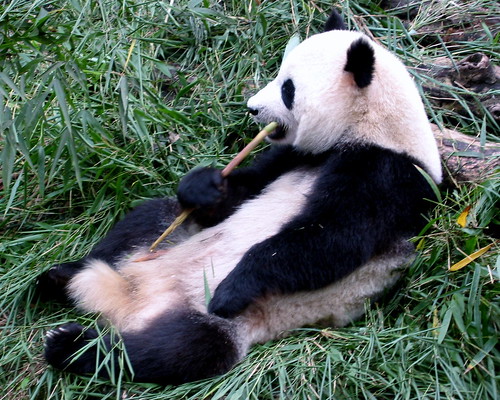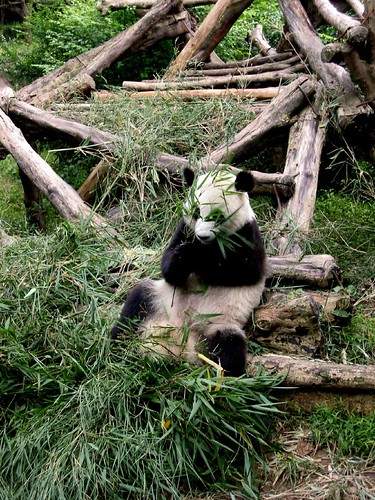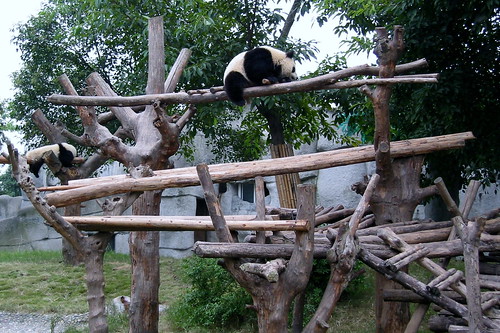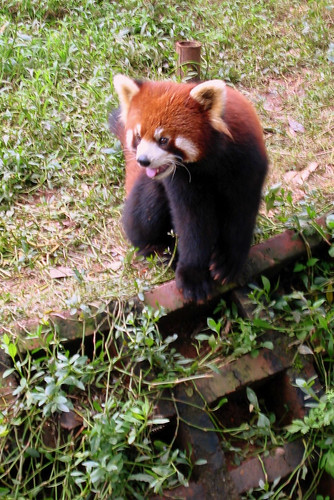can’t resist ‘em Chengdu pandas
If you think about it, who wouldn’t want to be a panda? You can lounge on grass any time of the day, snack at whim and to top it all, stay overweight and still be called cute, adorable and irresistible. Granted people will probably want to poke your stomach, but life as a panda does look grand.
In Chengdu Panda Conservation Park, you can get as close as you can ever get to the pandas other than in the wild. No other zoo in the world could offer such proximity to the cuddly bears and none could match its number of panda specimens either. Although the park has its share of visitors, mostly domestic, this one has no panda-viewing queues, as what I had to endure when I visited the San Diego Zoo several years back. There are no glass barriers, only a not-so-wide moat and a low-rise concrete fence. Quite refreshing if you asked me.
Canon PowerShot S40, 1/30s, f/4.9, 21.3mm
It pays of course to be situated right in the panda heartland of Sichuan Province, considered the largest natural habitat of the black and white bears. As the leading institution in the world, the park also is the epicenter of the efforts to rear these largely unproductive bears. As it happens, nature designs the pandas to not only mate rarely but also to have a low birthrate and high infant mortality.
Canon PowerShot S40, 0.03s, f/5.6, 21.3mm
The pandas live in large patches of bamboo groves in the park but because a panda typically eat 12-38kg of bamboo in a day, keepers constantly supply them with bushels of bamboo leaves to chew and devour.
While it is easy to dismiss the pandas as lazy, eating actually is a necessary habit for the creatures. They have to devote 40% of their time "dining" so as to maintain their body weight and remain healthy.
The rest of the panda’s time is spent for defecating, sleeping and of course, the requisite play. About 20% of the day, pandas are active in recreational activities. In the park, you can see them singly or in groups, whiling their playtime in wooden platforms specially made for them. Their movements look rather sluggish but considering their heft, they are quite sprightly, being able to climb elevated scaffoldings built to simulate timberland.
Canon PowerShot S40, 1/160s, f/3.5, 10.3mm
Another species that are featured in the park, and living harmoniously with the giant pandas are the red pandas. Considered as the closest genetic relative of the black and whites, the red pandas are not as endangered. Raccoon-like in countenance, they are quite amusing and cute in their own right, especially with their long bushy tails. Think of them as sly-moving foxes and not as bears at all.
As they multiply far faster than slumbering giants, the red pandas practically roam in large numbers around the park. They move quite fast and I amused myself into thinking that I can filch one to bring back as a pet in the house. (Not!)
Fortunately, the population of the giant pandas in the wild forests of Sichuan are picking up, thanks largely to the scientific breeding programs in parks like this one in Chengdu. The ultimate goal is to introduce captured giant pandas and their babies back into the wild.
Providing them freedom to be themselves, without much intervention from human, is key to their survival. Question is, who among us can resist?
To support the panda conservation effort, visit
http://www.panda.org
http://www.panda.org.cn






No comments:
Post a Comment